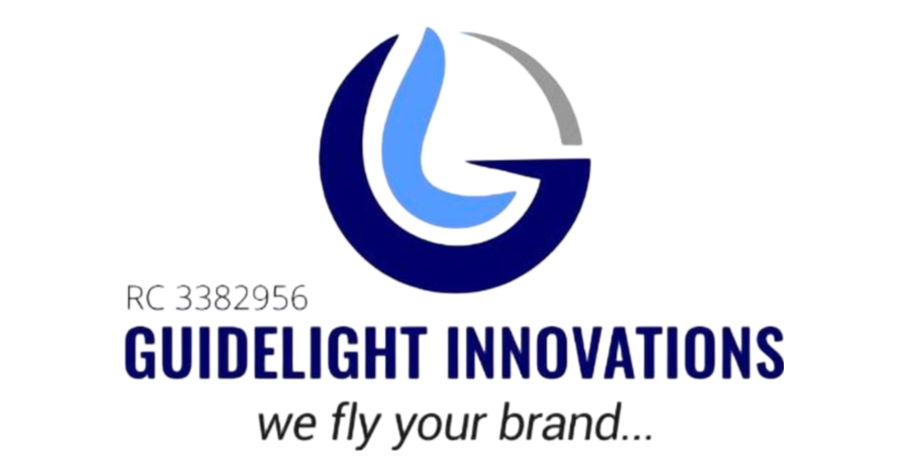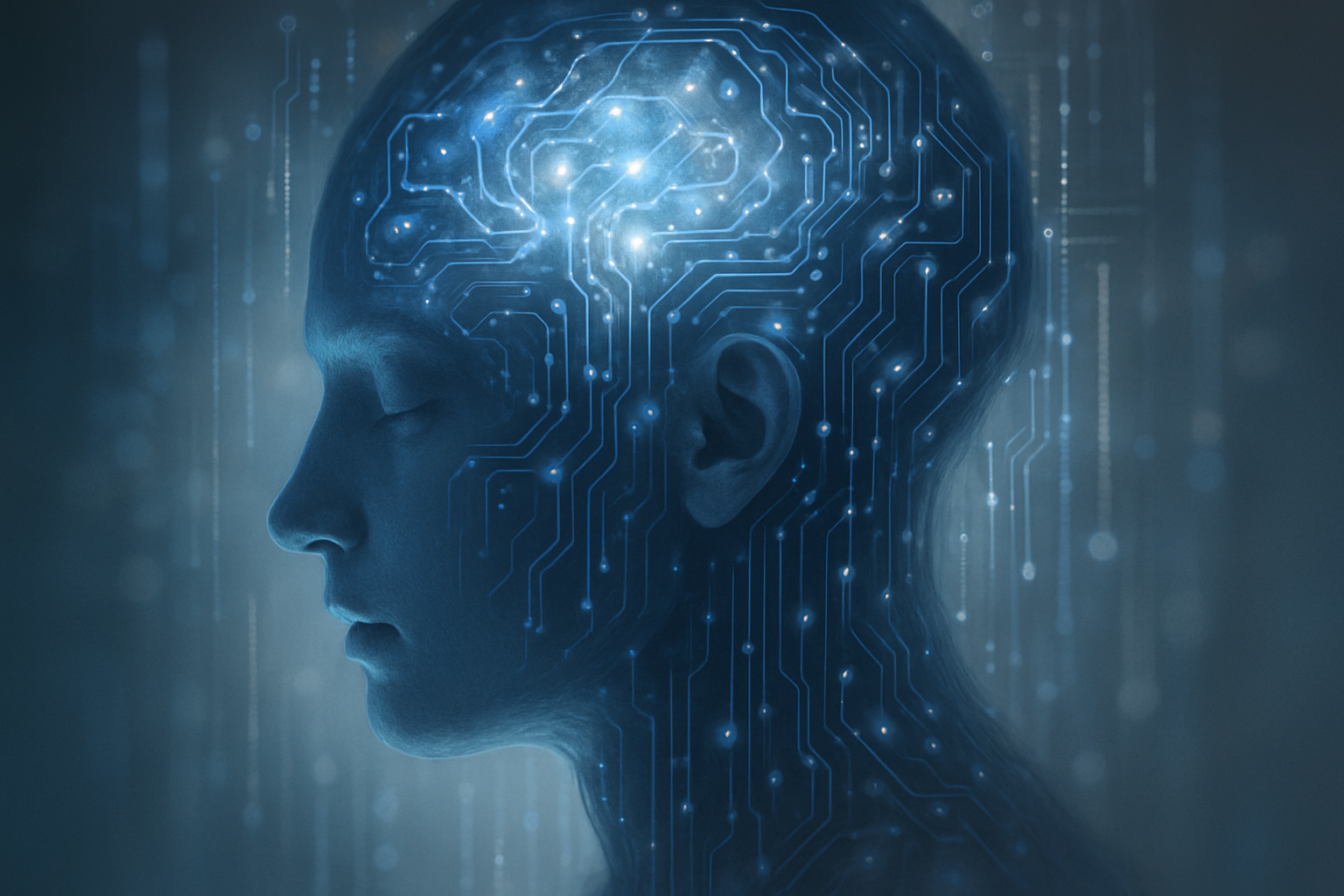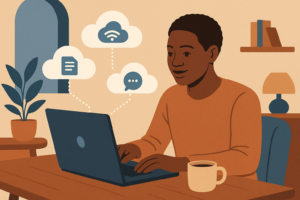The most profound technological revolutions occur not in the devices we hold but in the minds that hold them. While we debate screen time limits and social media algorithms, a more fundamental transformation unfolds beneath our awareness. Technology is rewiring human cognition in ways that affect how we process information, make decisions, form memories, and solve problems. For business owners, entrepreneurs, and individuals navigating the digital age, understanding these cognitive shifts isn’t merely academic—it’s essential for maintaining competitive advantage, productivity, and mental well-being.
The Outsourcing of Memory: When Google Becomes Our Second Brain
Human memory once served as the primary repository for information essential to daily life. We memorized phone numbers, directions, facts, procedures, and countless details necessary for functioning in the world. Today, we’ve outsourced this cognitive function to digital devices, fundamentally altering how our brains allocate processing resources.
This phenomenon, termed “cognitive offloading,” represents a profound shift in human information management. Research demonstrates that when people know information is easily accessible externally, they’re less likely to encode it into memory. We remember where to find information rather than the information itself. This isn’t forgetfulness—it’s cognitive adaptation to an environment of ubiquitous information access.
The implications for business operations are substantial. Employees no longer need to memorize procedures, product specifications, or technical details. Instead, they need skills in information retrieval, evaluation, and application. Training programs that emphasize memorization miss the point entirely. The competitive advantage lies not in what teams know but in how quickly and effectively they can access, synthesize, and apply available information.
However, this cognitive shift carries costs. Memory formation involves more than storage—it’s fundamental to understanding, creativity, and expertise development. When we deeply process information to encode it into memory, we create rich associative networks that enable insight and innovation. Superficial engagement with externally stored information may limit the depth of understanding necessary for genuine expertise.
Business leaders must navigate this tension thoughtfully. While leveraging digital tools for information storage and retrieval creates obvious efficiencies, over-reliance may undermine the deep knowledge that distinguishes experts from novices. The most effective approach combines strategic use of external information systems with deliberate cultivation of genuine expertise in critical domains.
Attention Fragmentation: The Erosion of Deep Focus
Perhaps the most visible cognitive impact of technology manifests in our diminishing capacity for sustained attention. The average office worker checks email every six minutes. Smartphone users touch their devices over 2,600 times daily. Notifications interrupt our focus dozens or hundreds of times each day. This constant fragmentation fundamentally alters cognitive function.
Neuroscience reveals that attention switching carries significant costs. Each interruption requires mental resources to disengage from the current task, process the interruption, and re-engage with the original task. This process, called “attention residue,” leaves cognitive resources allocated to the interrupting task even after returning to the primary task. The cumulative effect devastates productivity and cognitive performance.
Research by Gloria Mark at the University of California, Irvine demonstrates that after an interruption, it takes an average of 23 minutes to return to full focus on the original task. In environments with frequent interruptions, workers never achieve deep focus, instead operating in a perpetual state of partial attention that undermines quality output and increases error rates.
For businesses, the implications extend beyond individual productivity to affect innovation, problem-solving, and strategic thinking. Complex challenges require sustained cognitive engagement. Breakthrough insights emerge during extended periods of deep focus when the brain can fully explore problem spaces and generate novel connections. Fragmented attention environments systematically prevent the cognitive states necessary for innovation.
Progressive businesses are recognizing this reality and implementing “attention architecture” strategies. These include designated focus periods without meetings or communications, physical spaces designed for concentration, cultural norms that discourage constant connectivity, and tools that batch communications rather than delivering continuous interruptions. The companies that master attention management gain significant competitive advantages in output quality and innovation capacity.
The Shift from Linear to Associative Thinking
Traditional media—books, lectures, films—presented information linearly, training our minds to follow extended arguments, develop patience for complexity, and build understanding progressively. Digital media, particularly the web and social platforms, structure information associatively through hyperlinks, recommendations, and endless content streams. This structural difference is reshaping how we think.
Associative thinking offers advantages. The ability to make rapid connections across diverse information sources enables creativity and synthesis. Pattern recognition improves. Multidisciplinary insights emerge more readily. For businesses operating in complex, fast-changing environments, associative cognitive styles provide valuable flexibility and adaptability.
However, the decline of linear thinking carries costs. Complex arguments require sustained engagement with interconnected ideas building toward conclusions. Deep understanding of difficult subjects demands patience to work through challenging material systematically. These capabilities atrophy when cognitive patterns adapt to constant content hopping and surface-level engagement.
The business world increasingly values “T-shaped” professionals—individuals with broad knowledge across domains and deep expertise in specific areas. Developing this profile requires both associative breadth and linear depth. Organizations that recognize this need create learning environments supporting both cognitive styles rather than privileging one over the other.
Content strategy should similarly balance associative and linear approaches. While social media and fragmented digital content serve important purposes, longform content, structured training programs, and in-depth resources remain essential for developing genuine expertise and thought leadership. The most effective content ecosystems include diverse formats serving different cognitive needs and learning styles.
Decision-Making in the Age of Information Overload
Technology promised to improve decision-making by providing unprecedented access to information. The reality proves more complex. While information availability has increased exponentially, decision quality hasn’t improved proportionally. In many domains, it’s declined as cognitive overload undermines decision-making processes.
The phenomenon of “analysis paralysis” illustrates this challenge. Faced with excessive options and information, decision-makers struggle to process everything relevant, leading to decision delays or default choices. Research consistently shows that beyond a certain threshold, additional information degrades rather than improves decision quality as cognitive resources become overwhelmed.
Business leaders face this challenge acutely. Strategic decisions require synthesizing vast amounts of data, market intelligence, competitive analysis, and internal information. The availability of sophisticated analytics tools and big data creates pressure to analyze everything before deciding. However, the most effective leaders recognize that perfect information is impossible and excessive analysis wastes time and cognitive resources.
The shift toward “satisficing”—accepting good enough decisions rather than seeking optimal ones—represents cognitive adaptation to information abundance. Herbert Simon, who coined the term, argued that in complex environments with limited cognitive resources, seeking satisficing solutions actually demonstrates superior rationality compared to pursuing optimization.
For businesses, this suggests focusing decision-making frameworks on identifying what information truly matters rather than attempting comprehensive analysis. The 80/20 principle applies—typically 20% of available information drives 80% of decision value. Developing discernment about which information merits attention becomes more valuable than developing capacity to process more information.
The Decline of Boredom and Its Creative Consequences
Technology has virtually eliminated boredom from modern life. Every waiting moment, every idle minute, every period of potential stillness gets filled with digital content consumption. We scroll through feeds, check messages, watch videos, or play games during moments that previous generations experienced as empty time.
This shift carries profound cognitive implications. Boredom serves important psychological and creative functions. During unstimulated periods, the brain’s default mode network activates, engaging in internal processing that generates insights, consolidates memories, processes experiences, and produces creative connections. By eliminating boredom, we disable these essential cognitive processes.
Research demonstrates strong connections between mind-wandering and creativity. When external stimulation decreases, the mind naturally generates internal narratives, explores possibilities, and makes novel associations. Many breakthrough insights occur during activities that provide minimal external engagement—showers, walks, commutes—precisely because these conditions enable default mode network activation.
For businesses seeking innovation, the elimination of boredom represents a significant obstacle. Creative problem-solving requires both focused analytical thinking and diffuse associative processing. Organizations that keep employees constantly engaged with tasks and communications prevent the cognitive states necessary for genuine innovation.
Progressive companies are creating “white space” in work environments—designated periods without meetings, communications, or structured activities. Google’s famous 20% time policy, allowing employees to pursue projects of personal interest, recognizes that breakthrough innovation requires cognitive freedom rather than constant task focus. Similar approaches are emerging across innovative organizations.
Individuals must similarly protect unstructured time. Building periods of digital disconnection, engaging in activities requiring minimal cognitive engagement, and resisting the urge to fill every moment with content consumption all support the cognitive processes that generate creativity and insight. The most productive and innovative individuals aren’t those who maximize every moment but those who strategically incorporate cognitive rest.
Social Cognition in Digital Environments
Human cognition evolved in face-to-face social environments where communication involved verbal language, body language, facial expressions, tone, and countless subtle social cues. Digital communication strips away most of these signals, fundamentally altering social cognition and interpersonal understanding.
The absence of non-verbal cues in digital communication creates systematic misunderstanding. Text lacks tone indicators, making sarcasm indistinguishable from sincerity, playfulness from aggression, thoughtfulness from dismissiveness. Email and messaging studies show that readers correctly identify emotional tone only about 50% of the time—essentially random chance. This communication degradation creates friction in personal relationships and business contexts alike.
The asynchronous nature of much digital communication affects social dynamics profoundly. In face-to-face conversation, responses occur within seconds, creating natural flow and immediate feedback. Digital communication often involves hours or days between messages, disrupting conversational rhythm and social connection. The delay creates anxiety, misunderstanding, and relationship strain that immediate communication would prevent.
For businesses, these social cognition challenges affect team cohesion, customer relationships, and organizational culture. Remote work environments relying heavily on digital communication face systematic disadvantages in building trust, resolving conflicts, and maintaining strong interpersonal bonds. Companies that recognize these challenges implement strategies to compensate—regular video calls instead of text-only communication, periodic in-person gatherings, and training on effective digital communication.
The rise of emoji, GIFs, and other digital paralanguage represents attempts to restore missing social cues to digital communication. These tools serve important functions but provide only partial compensation for the richness of in-person interaction. Businesses should view them not as frivolous but as essential tools for humanizing digital communication and reducing misunderstanding.
The Transformation of Reading: From Deep to Shallow
Reading represents a relatively recent human cognitive achievement, enabled by brain plasticity that repurposes existing neural circuits for this cultural invention. Different reading contexts—deep reading of books versus scanning of digital content—activate different neural pathways and produce different cognitive outcomes.
Deep reading involves sustained engagement with text, allowing time for reflection, inference, critical analysis, and emotional connection. The brain builds complex mental models, makes predictions, questions assumptions, and integrates information with existing knowledge. This cognitive processing develops critical thinking skills, empathy, and deep comprehension.
Digital reading tends toward scanning, skimming, and fragmented engagement. The prevalence of hyperlinks, advertisements, and notifications encourages jumping between content rather than sustained focus. Research by Maryanne Wolf and others demonstrates that extensive digital reading actually changes brain structure, strengthening circuits for rapid information sampling while weakening circuits for deep processing.
For business professionals, these changes affect learning capacity and analytical ability. Deep understanding of complex business topics—strategy, leadership, technical domains—requires sustained cognitive engagement that digital reading habits undermine. The professional who can read deeply maintains advantages in expertise development and strategic thinking.
Content creators must recognize that audience reading patterns have shifted. Longform content requires different presentation strategies than previously. Strategic use of subheadings, bullet points, emphasis, and white space accommodates scanning behavior while still delivering substantive information. However, some content must resist adaptation and demand deep engagement, particularly when developing genuine expertise justifies the cognitive investment.
Organizations should cultivate reading cultures that value deep engagement with important material. Encouraging book reading, providing time for thoughtful document review, and designing training materials that require sustained attention all support cognitive capabilities essential for organizational effectiveness.
Spatial Cognition and Navigation: The GPS Effect
Human spatial cognition and navigation abilities served crucial evolutionary functions. Building mental maps, understanding spatial relationships, and navigating environments without external aids required significant cognitive resources and developed important neural structures, particularly in the hippocampus.
GPS navigation technology has largely replaced these cognitive functions. Rather than learning routes, understanding spatial relationships, and developing mental maps, we follow turn-by-turn directions provided by devices. Research shows that GPS users develop poorer spatial knowledge of areas they regularly navigate compared to traditional map users or those navigating without aids.
This change appears to have structural neural consequences. Studies of London taxi drivers, who must memorize the city’s complex street layout, show enlarged hippocampi compared to non-taxi drivers. The cognitive demands of navigation appear to strengthen neural structures important for memory and spatial reasoning. Conversely, GPS dependence may allow these structures to atrophy.
For businesses, the implications extend beyond navigation. The cognitive skills developed through spatial reasoning—mental visualization, relationship mapping, system thinking—transfer to other domains including strategy, design, and problem-solving. Workforce cognitive capabilities may be quietly eroding as fundamental cognitive exercises like navigation disappear from daily life.
The solution isn’t abandoning useful technology but recognizing when cognitive engagement benefits development. Occasionally navigating without GPS, engaging with physical maps, and practicing spatial reasoning exercises all maintain important cognitive capabilities. Organizations can incorporate spatial reasoning activities into training and development programs to strengthen these transferable skills.
The Reshaping of Patience and Reward Systems
Technology has dramatically compressed the time between desire and satisfaction. Immediate information access, instant communication, on-demand entertainment, and rapid delivery services have recalibrated our temporal expectations and neural reward systems. We’ve become accustomed to minimal delay between wanting and having.
This temporal compression affects dopamine systems in the brain. Dopamine release relates not just to rewards but to reward prediction and timing. When rewards arrive quickly and predictably, the brain’s dopamine response patterns change. Tolerance develops, requiring stronger or faster rewards to produce equivalent satisfaction. This creates a hedonic treadmill where satisfaction becomes increasingly elusive despite increasing reward frequency.
The business implications manifest in employee expectations, customer behavior, and organizational patience for strategy execution. Employees accustomed to constant feedback and rapid results struggle with projects requiring sustained effort before outcomes materialize. Customers demand instant response, immediate delivery, and real-time service. Organizations struggle to maintain commitment to long-term strategies when short-term metrics provide constant feedback.
Successful leaders recognize this challenge and actively cultivate patience—in themselves, their teams, and their organizations. This includes setting appropriate expectations about timelines, celebrating process milestones rather than only outcomes, and protecting long-term initiatives from short-term pressures. The ability to delay gratification and maintain focus on distant goals becomes a significant competitive advantage in environments where most competitors optimize for immediate returns.
Training programs can incorporate exercises that develop patience and delayed gratification. Meditation practices, complex projects requiring sustained effort, and deliberate waiting periods before evaluating results all strengthen neural circuits supporting patience. These capabilities increasingly differentiate high performers from those trapped in constant immediate gratification seeking.
Cognitive Load and Mental Exhaustion
The digital environment imposes unprecedented cognitive load on human minds. Constant switching between tasks, filtering relevant from irrelevant information, making countless micro-decisions about attention allocation, and processing massive information volumes all consume cognitive resources. The result is chronic mental exhaustion that affects health, productivity, and well-being.
Decision fatigue represents one manifestation of this overload. Every decision, no matter how trivial, depletes finite cognitive resources. The abundance of choices in modern life—from email responses to content consumption to product selection—creates cumulative cognitive drain. Research shows that decision quality deteriorates throughout the day as cognitive resources deplete, affecting everything from judicial rulings to consumer purchases.
For business leaders, decision fatigue affects the quality of strategic choices and leadership effectiveness. The leaders who recognize this reality protect their cognitive resources through systematic decision reduction. Steve Jobs famously wore the same outfit daily to eliminate clothing decisions. Many successful leaders establish routines that automate trivial choices, batch decisions to reduce switching costs, and delegate decisions that don’t require their unique expertise.
Organizations can design work environments that reduce cognitive load on employees. This includes simplifying workflows, reducing unnecessary communications, providing clear decision frameworks, and eliminating busywork that consumes attention without adding value. The companies that win the competition for talent increasingly recognize that cognitive load management represents a crucial employee benefit and productivity driver.
Digital minimalism—the intentional reduction of digital tool usage to essential applications—provides individuals with strategies for managing cognitive load. Rather than using every available app, platform, and tool, successful professionals carefully curate their digital environments to include only tools providing clear value. This curation reduces cognitive overhead and preserves mental resources for high-value activities.
The Evolution of Learning and Skill Acquisition
Technology has transformed not just what we learn but how we learn. The availability of online courses, video tutorials, just-in-time information access, and diverse learning platforms has democratized education while also changing the cognitive processes involved in skill acquisition.
The traditional learning model involved sustained engagement with challenging material, practice under expert guidance, and gradual skill development over extended periods. This approach builds deep expertise through cognitive struggle—the productive difficulty that strengthens learning. Modern learning often emphasizes convenience, speed, and accessibility over cognitive challenge.
Microlearning—brief learning modules consumed in small time increments—represents one adaptation to contemporary attention patterns. While this approach offers advantages for certain content types, it may undermine development of complex skills requiring sustained cognitive engagement. The business professional who builds expertise through 5-minute video tutorials likely develops different and potentially shallower knowledge compared to one who works through challenging problems systematically.
For businesses, this evolution affects workforce development strategies. Training programs must balance accessibility and engagement with the cognitive depth necessary for genuine skill development. The most effective approaches combine convenient digital resources with challenging application exercises that require productive struggle and deep processing.
Self-directed learning has become essential as the half-life of professional skills continues shrinking. The ability to learn efficiently becomes more valuable than any specific knowledge. Organizations that help employees develop metacognitive skills—learning how to learn—provide lasting value that transcends specific content.
Strategic Responses: Thriving Amid Cognitive Change
Understanding how technology changes cognition enables strategic responses that harness benefits while mitigating costs. For business owners and individuals, several principles guide effective navigation of this transformation.
First, recognize that cognitive changes represent adaptation rather than deterioration. Human brains have always adapted to environmental demands. Agricultural civilization changed cognitive patterns from hunter-gatherer ancestors. Written language transformed memory and reasoning. Each technological era reshapes cognition. The goal isn’t preservation of historical cognitive patterns but intentional development of capabilities that serve contemporary needs.
Second, cultivate cognitive diversity within organizations and personal practice. Different cognitive modes serve different purposes. Associative thinking enables creativity. Linear thinking supports complex reasoning. Deep focus produces quality output. Distributed attention enables broad awareness. The most effective approach integrates diverse cognitive capabilities rather than specializing in any single mode.
Third, design environments that support desired cognitive outcomes. Physical spaces, digital tools, organizational policies, and cultural norms all shape cognition. Intentional environment design produces better results than passive acceptance of default technology configurations. This includes strategic choices about communication tools, workspace design, meeting culture, and attention norms.
Fourth, practice cognitive maintenance through deliberate exercises. Just as physical fitness requires regular exercise, cognitive capabilities benefit from intentional practice. Reading books maintains deep processing abilities. Memorization exercises strengthen encoding capabilities. Navigation without GPS preserves spatial reasoning. Meditation develops attention control. Strategic incorporation of cognitive exercises prevents atrophy of important capabilities.
Fifth, recognize individual differences in cognitive adaptation. People vary in their susceptibility to technology-driven cognitive changes based on genetics, development, and habits. What works for one person may not work for another. Effective strategies require self-awareness and experimentation to discover personal optimal approaches rather than universal prescriptions.
Conclusion: Conscious Evolution in the Digital Age
Technology’s impact on human cognition represents neither simple progress nor decline but complex transformation with costs and benefits requiring thoughtful navigation. The business owners, entrepreneurs, and individuals who thrive in this environment are those who understand these changes and respond strategically rather than passively accepting default patterns.
The competitive advantages increasingly accrue not to those with fastest information access or most digital tools but to those who maintain cognitive capabilities that technology undermines—deep focus, patience, spatial reasoning, face-to-face social intelligence, and sustained analytical thinking. These capabilities become differentiators precisely because they’re becoming rare.
Organizations that recognize these dynamics and actively support cognitive health—through environment design, work practices, and cultural norms—will attract and retain top talent while producing superior outcomes. The companies that win won’t be those most thoroughly digitized but those that most thoughtfully integrate technology while preserving essential human cognitive capabilities.
For individuals, thriving requires intentionality about technology relationships. Passive consumption of whatever technology delivers produces cognitive patterns optimized for technological convenience rather than human flourishing. Active curation of digital environments, deliberate cognitive exercise, and strategic technology use enable adaptation that enhances rather than diminishes human capability.
The transformation of human cognition by technology continues accelerating. Artificial intelligence, augmented reality, brain-computer interfaces, and technologies yet imagined will drive further changes. The humans and organizations that prosper won’t be those who resist change or embrace it uncritically but those who engage consciously with these transformations, cultivating the wisdom to know which cognitive changes serve human flourishing and which undermine it.
The question isn’t whether technology changes how we think—it clearly does. The question is whether we’ll allow those changes to happen unconsciously or shape them intentionally toward outcomes we value. The choice remains ours, but only if we make it deliberately and soon.
References
- Carr, N. (2020). “The Shallows: What the Internet Is Doing to Our Brains.” W. W. Norton & Company. (Updated edition)
- Finkel, E.J., Bail, C.A., Cikara, M., Ditto, P.H., Iyengar, S., Klar, S., et al. (2020). “Political Sectarianism in America.” Science, 370(6516), 533-536.
- Kushlev, K., Proulx, J., & Dunn, E.W. (2023). “Digitally Distracted: Understanding the Relationship Between Digital Technology Use and Attention.” Current Directions in Psychological Science, 32(2), 155-162.
- Maguire, E.A., Woollett, K., & Spiers, H.J. (2021). “London Taxi Drivers and Bus Drivers: A Structural MRI and Neuropsychological Analysis.” Hippocampus, 16(12), 1091-1101.
- Mark, G., Iqbal, S.T., Czerwinski, M., Johns, P., & Sano, A. (2022). “Email Duration, Batching and Self-interruption: Patterns of Email Use on Productivity and Stress.” Proceedings of the CHI Conference on Human Factors in Computing Systems, 1-14.
- Newport, C. (2021). “A World Without Email: Reimagining Work in an Age of Communication Overload.” Portfolio/Penguin.
- Sparrow, B., Liu, J., & Wegner, D.M. (2020). “Google Effects on Memory: Cognitive Consequences of Having Information at Our Fingertips.” Science, 333(6043), 776-778.
- Storm, B.C., & Stone, S.M. (2023). “Saving-Enhanced Memory: The Benefits of Saving on the Learning and Remembering of New Information.” Psychological Science, 26(2), 182-188.
- Ward, A.F., Duke, K., Gneezy, A., & Bos, M.W. (2021). “Brain Drain: The Mere Presence of One’s Own Smartphone Reduces Available Cognitive Capacity.” Journal of the Association for Consumer Research, 2(2), 140-154.
- Wolf, M. (2022). “Reader, Come Home: The Reading Brain in a Digital World.” Harper Perennial. (Revised edition)
Additional Resources
- Center for Humane Technology: https://www.humanetech.com – Resources on technology’s impact on human psychology and society with actionable strategies for individuals and organizations
- MIT Technology Review: https://www.technologyreview.com/topic/neuroscience/ – Cutting-edge research and analysis on neuroscience, cognition, and technology intersection
- Harvard Business Review – Productivity: https://hbr.org/topic/productivity – Research-based insights on maintaining cognitive performance and productivity in digital environments
- Digital Wellness Institute: https://www.digitalwellnessinstitute.com – Evidence-based resources for developing healthy relationships with technology
- American Psychological Association – Technology and Mental Health: https://www.apa.org/topics/social-media-internet – Research summaries and guidelines on technology’s psychological impacts
- Cal Newport’s Blog: https://calnewport.com/blog/ – Practical strategies for deep work, digital minimalism, and cognitive performance
- Scientific American Mind: https://www.scientificamerican.com/mind/ – Accessible neuroscience and psychology research including technology’s cognitive effects
- Stanford Human-Computer Interaction Group: https://hci.stanford.edu – Academic research on how digital interfaces affect human cognition and behavior




